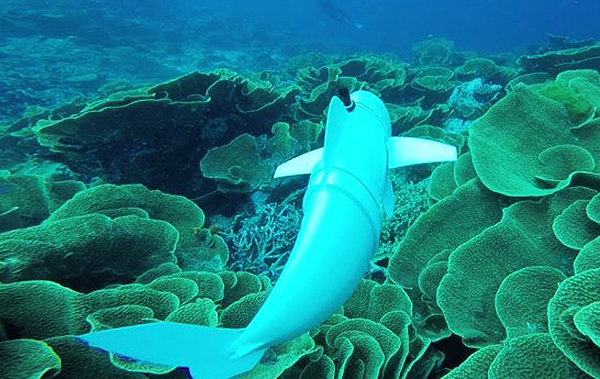
MIT’s new robotic fish, named SoFi, cruises over a reef in Fiji. Image: CreditJoseph DelPreto and Robert Katzschmann/MIT/CSAIL
Meet SoFi, the brainchild of scientists from the Massachusetts Institute of Technology who have unleashed the first free-swimming, soft-bodied robotic fish with a mission of studying elusive sealife dwelling beyond the limits of most human divers.
During test dives in the Rainbow Reef in Fiji, the unique new, soft-bodied robotic fish dubbed SoFi swam at depths of more than 50 feet for up to 40 minutes, nimbly handling currents and taking high-resolution photos and videos using (what else?) a fisheye lens.
Using its undulating tail and a unique ability to control its own buoyancy, SoFi can swim in a straight line, turn, or dive up or down. The team also used a waterproofed Super Nintendo controller and developed a custom acoustic communications system that enabled them to change SoFi’s speed and have it make specific moves and turns.
“To our knowledge, this is the first robotic fish that can swim untethered in three dimensions for extended periods of time,” says CSAIL PhD candidate Robert Katzschmann, lead author of the new journal article published today in Science Robotics. “We are excited about the possibility of being able to use a system like this to get closer to marine life than humans can get on their own.”
Katzschmann worked on the project and wrote the paper with CSAIL director Daniela Rus, graduate student Joseph DelPreto and former postdoc Robert MacCurdy, who is now an assistant professor at the University of Colorado at Boulder.
Watch SoFi swim the reefs of Fiji:
From materials released by the Massachusetts Institute of Technology Computer Science and Artificial Intelligence Lab.
Exploration of underwater life with an acoustically controlled soft robotic fish
Robert K. Katzschmann, Joseph DelPreto, Robert MacCurdy and Daniela Rus
Science Robotics 21 Mar 2018:
Vol. 3, Issue 16, eaar3449
DOI: 10.1126/scirobotics.aar3449
Abstract
Closeup exploration of underwater life requires new forms of interaction, using biomimetic creatures that are capable of agile swimming maneuvers, equipped with cameras, and supported by remote human operation. Current robotic prototypes do not provide adequate platforms for studying marine life in their natural habitats. This work presents the design, fabrication, control, and oceanic testing of a soft robotic fish that can swim in three dimensions to continuously record the aquatic life it is following or engaging. Using a miniaturized acoustic communication module, a diver can direct the fish by sending commands such as speed, turning angle, and dynamic vertical diving. This work builds on previous generations of robotic fish that were restricted to one plane in shallow water and lacked remote control. Experimental results gathered from tests along coral reefs in the Pacific Ocean show that the robotic fish can successfully navigate around aquatic life at depths ranging from 0 to 18 meters. Furthermore, our robotic fish exhibits a lifelike undulating tail motion enabled by a soft robotic actuator design that can potentially facilitate a more natural integration into the ocean environment. We believe that our study advances beyond what is currently achievable using traditional thruster-based and tethered autonomous underwater vehicles, demonstrating methods that can be used in the future for studying the interactions of aquatic life and ocean dynamics.
Online




